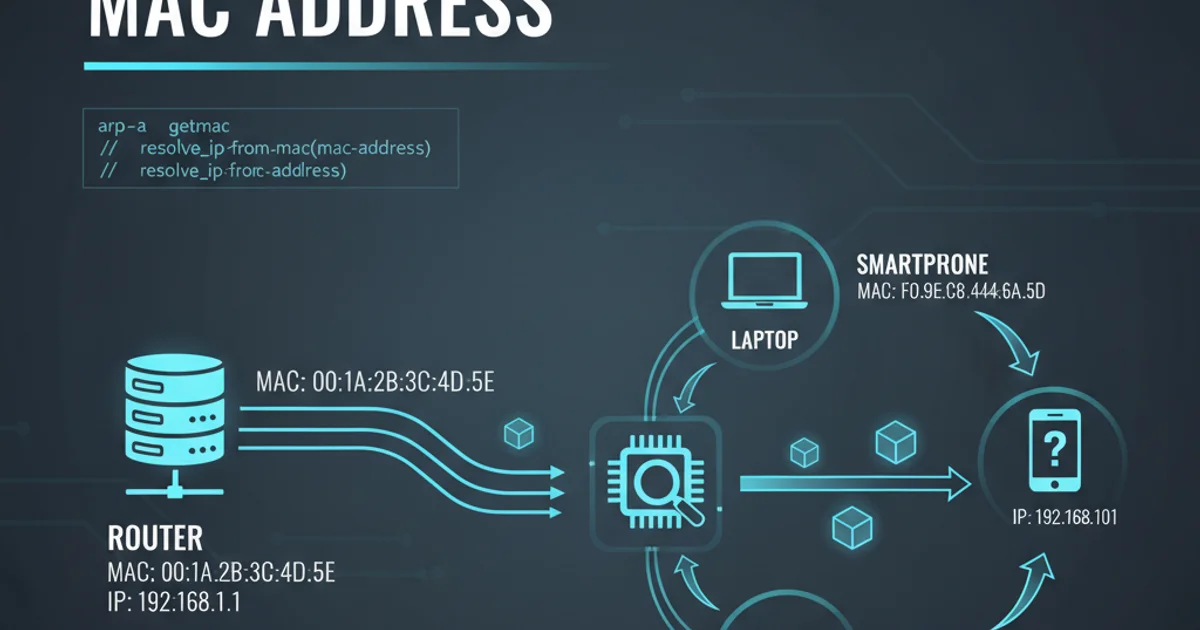Get IP Address from Mac Address
Categories:
Resolving IP Addresses from MAC Addresses

Learn how to discover the IP address associated with a known MAC address on a local network, focusing on practical methods for network diagnostics and device identification.
Identifying devices on a local network often involves mapping their physical (MAC) addresses to their logical (IP) addresses. This is a common task in network administration, security auditing, and IoT device management, especially for devices like Raspberry Pis that might not have a display. While a MAC address uniquely identifies a network interface card, an IP address is what allows devices to communicate over a network. This article explores several methods to resolve an IP address from a known MAC address, primarily focusing on tools available in Linux environments, which are highly relevant for Raspberry Pi users.
Understanding ARP and Network Discovery
The Address Resolution Protocol (ARP) is a fundamental protocol in TCP/IP networks that maps IP network addresses to the hardware addresses used by a data link protocol. When a device wants to communicate with another device on the same local network, it uses ARP to find the destination device's MAC address given its IP address. Conversely, if you have a MAC address and want to find its IP, you typically need to trigger an ARP request for the device or inspect the ARP cache of a device that has recently communicated with it.
flowchart TD
A[Start with MAC Address] --> B{Is device active on network?}
B -->|No| C[Ping Broadcast Address / Scan Network]
B -->|Yes| D[Check ARP Cache (arp -a)]
C --> D
D --> E{MAC Address found in cache?}
E -->|Yes| F[Extract IP Address]
E -->|No| G[Wait for ARP entry or re-scan]
F --> H[End: IP Address Found]
G --> HProcess for resolving an IP address from a MAC address
Methods for IP Resolution
There are several approaches to finding an IP address from a MAC address, ranging from simple command-line tools to more advanced network scanning utilities. The effectiveness of each method often depends on whether the target device is currently active and communicating on the network.
1. Method 1: Using arp -a (ARP Cache)
The arp -a command displays the ARP cache of your local machine. This cache contains recent mappings of IP addresses to MAC addresses for devices your machine has communicated with. If your machine has recently interacted with the target device, its IP address might already be listed.
2. Method 2: Pinging the Broadcast Address
To populate your ARP cache with entries for all active devices on your local network, you can ping the network's broadcast address. This forces all devices to respond, thereby updating your ARP cache. After pinging, you can then check arp -a.
3. Method 3: Using nmap for Network Scanning
nmap is a powerful network discovery and security auditing tool. It can scan an entire subnet and report active hosts, including their MAC addresses and corresponding IP addresses. This is often the most reliable method for discovering devices.
4. Method 4: Checking Router's DHCP Lease Table
Your network router typically acts as a DHCP server, assigning IP addresses to devices. Most routers have an administrative interface where you can view the DHCP lease table, which lists MAC addresses and their assigned IP addresses. This is often the easiest method if you have access to the router.
Practical Examples
Let's look at how to implement these methods using command-line tools, particularly useful for Raspberry Pi users.
# 1. Check local ARP cache
arp -a
# Example output:
# ? (192.168.1.1) at 00:11:22:33:44:55 [ether] on eth0
# ? (192.168.1.100) at AA:BB:CC:DD:EE:FF [ether] on eth0
# 2. Ping broadcast address to populate ARP cache (replace with your network's broadcast)
ping -b 192.168.1.255 -c 1
# After pinging, wait a few seconds, then run:
arp -a
# 3. Scan network with nmap (replace with your network range)
sudo nmap -sn 192.168.1.0/24
# Example nmap output snippet:
# Nmap scan report for 192.168.1.100
# Host is up (0.0010s latency).
# MAC Address: AA:BB:CC:DD:EE:FF (Raspberry Pi Foundation)
# 4. Accessing router's DHCP table (conceptual - varies by router model)
# Typically via web browser: http://192.168.1.1 (or your router's IP)
# Look for sections like 'DHCP Clients', 'Connected Devices', or 'LAN Settings'.
Command-line examples for IP address resolution
nmap with sudo is often required for full functionality, especially for MAC address detection. Be mindful of network policies when running network scans, as they can sometimes be flagged by intrusion detection systems.